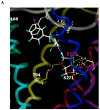Orthogonal activation of the reengineered A3 adenosine receptor (neoceptor) using tailored nucleoside agonists
- PMID: 16640329
- PMCID: PMC3471142
- DOI: 10.1021/jm050968b
Orthogonal activation of the reengineered A3 adenosine receptor (neoceptor) using tailored nucleoside agonists
Abstract
An alternative approach to overcome the inherent lack of specificity of conventional agonist therapy can be the reengineering of the GPCRs and their agonists. A reengineered receptor (neoceptor) could be selectively activated by a modified agonist, but not by the endogenous agonist. Assisted by rhodopsin-based molecular modeling, we pinpointed mutations of the A(3) adenosine receptor (AR) for selective affinity enhancement following complementary modifications of adenosine. Ribose modifications examined included, at 3': amino, aminomethyl, azido, guanidino, ureido; and at 5': uronamido, azidodeoxy. N(6)-Variations included 3-iodobenzyl, 5-chloro-2-methyloxybenzyl, and methyl. An N(6)-3-iodobenzyl-3'-ureido adenosine derivative 10 activated phospholipase C in COS-7 cells (EC(50) = 0.18 microM) or phospholipase D in chick primary cardiomyocytes, both mediated by a mutant (H272E), but not the wild-type, A(3)AR. The affinity enhancements for 10 and the corresponding 3'-acetamidomethyl analogue 6 were >100-fold and >20-fold, respectively. 10 concentration-dependently protected cardiomyocytes transfected with the neoceptor against hypoxia. Unlike 10, adenosine activated the wild-type A(3)AR (EC(50) of 1.0 microM), but had no effect on the H272E mutant A(3)AR (100 microM). Compound 10 was inactive at human A(1), A(2A), and A(2B)ARs. The orthogonal pair comprising an engineered receptor and a modified agonist should be useful for elucidating signaling pathways and could be therapeutically applied to diseases following organ-targeted delivery of the neoceptor gene.
Figures






Similar articles
-
Probing the binding site of the A1 adenosine receptor reengineered for orthogonal recognition by tailored nucleosides.Biochemistry. 2007 Jun 26;46(25):7437-48. doi: 10.1021/bi7001828. Epub 2007 Jun 2. Biochemistry. 2007. PMID: 17542617 Free PMC article.
-
(N)-methanocarba 2,N6-disubstituted adenine nucleosides as highly potent and selective A3 adenosine receptor agonists.J Med Chem. 2005 Mar 24;48(6):1745-58. doi: 10.1021/jm049580r. J Med Chem. 2005. PMID: 15771421 Free PMC article.
-
Neoceptor concept based on molecular complementarity in GPCRs: a mutant adenosine A(3) receptor with selectively enhanced affinity for amine-modified nucleosides.J Med Chem. 2001 Nov 22;44(24):4125-36. doi: 10.1021/jm010232o. J Med Chem. 2001. PMID: 11708915 Free PMC article.
-
Action of nucleosides and nucleotides at 7 transmembrane-spanning receptors.Nucleosides Nucleotides Nucleic Acids. 2006;25(12):1425-36. doi: 10.1080/15257770600919027. Nucleosides Nucleotides Nucleic Acids. 2006. PMID: 17067963 Free PMC article. Review.
-
Structural Probing and Molecular Modeling of the A₃ Adenosine Receptor: A Focus on Agonist Binding.Molecules. 2017 Mar 11;22(3):449. doi: 10.3390/molecules22030449. Molecules. 2017. PMID: 28287473 Free PMC article. Review.
Cited by
-
Adenosine receptors as therapeutic targets.Nat Rev Drug Discov. 2006 Mar;5(3):247-64. doi: 10.1038/nrd1983. Nat Rev Drug Discov. 2006. PMID: 16518376 Free PMC article. Review.
-
Click modification in the N6 region of A3 adenosine receptor-selective carbocyclic nucleosides for dendrimeric tethering that preserves pharmacophore recognition.Bioconjug Chem. 2012 Feb 15;23(2):232-47. doi: 10.1021/bc200526c. Epub 2012 Jan 11. Bioconjug Chem. 2012. PMID: 22175234 Free PMC article.
-
Probing the binding site of the A1 adenosine receptor reengineered for orthogonal recognition by tailored nucleosides.Biochemistry. 2007 Jun 26;46(25):7437-48. doi: 10.1021/bi7001828. Epub 2007 Jun 2. Biochemistry. 2007. PMID: 17542617 Free PMC article.
-
Translocation of arrestin induced by human A(3) adenosine receptor ligands in an engineered cell line: comparison with G protein-dependent pathways.Pharmacol Res. 2008 Apr;57(4):303-11. doi: 10.1016/j.phrs.2008.02.008. Epub 2008 Mar 8. Pharmacol Res. 2008. PMID: 18424164 Free PMC article.
-
Synthesis of N6-substituted 3'-ureidoadenosine derivatives as highly potent agonists at the mutant A3 adenosine receptor.Nucleosides Nucleotides Nucleic Acids. 2007;26(6-7):717-9. doi: 10.1080/15257770701493161. Nucleosides Nucleotides Nucleic Acids. 2007. PMID: 18066887 Free PMC article.
References
-
- Buskirk AR, Liu DR. Creating small-molecule-dependent switches to modulate biological functions. Chem Biol. 2005;12:151–161. - PubMed
-
- Hwang YW, Miller DL. A mutation that alters the nucleotide specificity of elongation factor Tu, a GTP regulatory protein. J Biol Chem. 1987;262:13081–13085. - PubMed
-
- Niculescu-Duvaz I, Friedlos F, Niculescu-Duvaz D, Davies L, Springer CJ. Prodrugs for antibody- and gene-directed enzyme prodrug therapies (ADEPT and GDEPT) Anticancer Drug Des. 1999;14:517–538. - PubMed
-
- Hashimoto A, Shi Y, Drake K, Koh JT. Design and synthesis of complementing ligands for mutant thyroid hormone receptor TRbeta(R320H): a tailor-made approach toward the treatment of resistance to thyroid hormone. Bioorg Med Chem. 2005;13:3627–3639. - PubMed
-
- Strausberg RL, Schreiber SL. From knowing to controlling: a path from genomics to drugs using small molecule probes. Sci. 2003;300:294–295. - PubMed
Publication types
MeSH terms
Substances
Grants and funding
LinkOut - more resources
Full Text Sources
Other Literature Sources
Chemical Information
Research Materials

